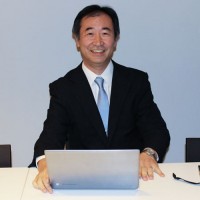By Hamish Johnston

Eureka moment: Takaaki Kajita’s Nobel journey began when he was improving software. (Courtesy: Takaaki Kajita)
This morning I had the pleasure of speaking with Takaaki Kajita, who shared this year’s Nobel Prize for Physics. He won for discovering that some of the muon neutrinos produced by cosmic-ray collisions in the atmosphere change flavour as they travel to Earth. This phenomenon, called neutrino oscillation, tells us that neutrinos have mass – something that was not initially included in the Standard Model of particle physics.
From his office at the University of Tokyo, Kajita told me that the story began in 1986 when he was working on a proton-decay experiment at the Kamioka underground lab in Japan. He was trying to improve some software that was designed to discriminate between electrons and muons created within the detector. He noticed that there were fewer events associated with muon neutrinos than expected. Muon neutrinos are created in the atmosphere when cosmic rays collide with air molecules and a possible explanation for the deficit was that some of the muon neutrinos were oscillating into electron neutrinos on their journey to the detector. Looking back, however, Kajita told me that his initial reaction to the deficit was that he must have made a mistake in his analysis.
But it was no mistake, and Kajita realized that by detecting relatively high-energy muon neutrinos, physicists could work out where in the atmosphere the particles had been produced. Specifically, they could tell the difference between a neutrino produced in the atmosphere above in Japan and a neutrino that had been produced on the other side of the world. By comparing the relative abundance of these neutrinos, the researchers could show that the neutrinos that travelled the longest distances to the detector – through the centre of the Earth – were more likely to oscillate.
This was tested in the SuperKamiokande experiment, which began in 1996. By 1998 Kajita and colleagues had collected enough muon neutrinos to show that oscillation was occurring. A few years later Art McDonald and colleagues at the Sudbury Neutrino Observatory in Canada measured the oscillation of electron neutrinos created in the Sun – for which McDonald shared the 2015 Nobel with Kajita.
Not a bad outcome for tinkering around with software.
This story takes me back to an obituary written by Steven Chu. As noted in that, Arthur Schawlow used to encourage young researcher by saying “you need not know whole physics but you must know that one which is not known to others”.
Trackback: How to win a Nobel prize – MyPhysNet